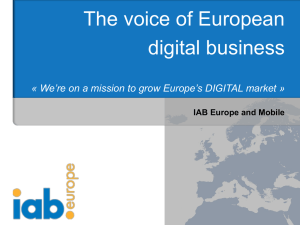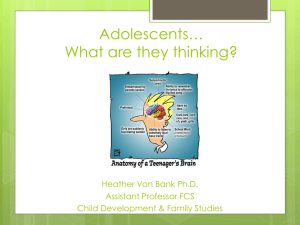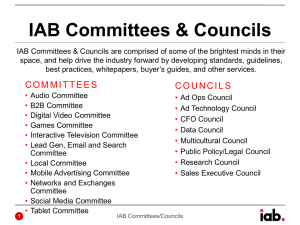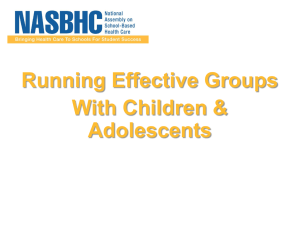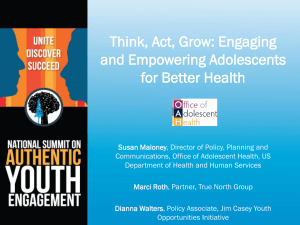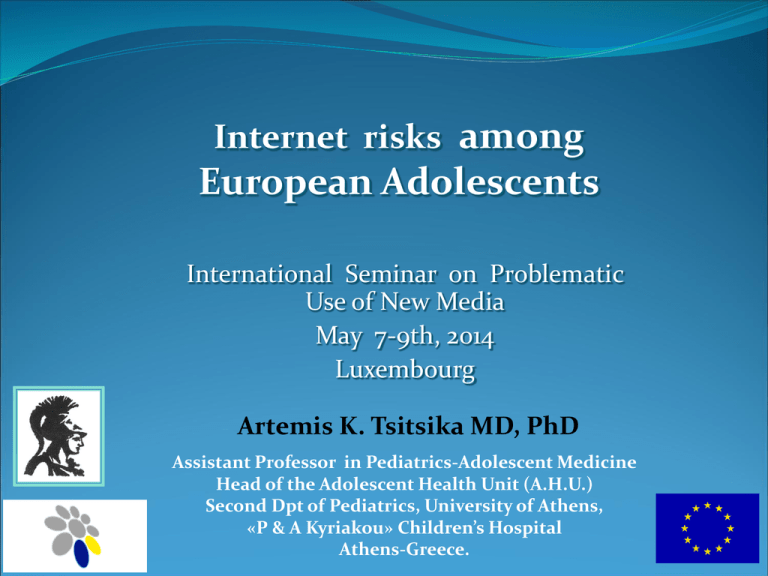
Internet risks among
European Adolescents
International Seminar on Problematic
Use of New Media
May 7-9th, 2014
Luxembourg
Artemis K. Tsitsika MD, PhD
Assistant Professor in Pediatrics-Adolescent Medicine
Head of the Adolescent Health Unit (Α.H.U.)
Second Dpt of Pediatrics, University of Athens,
«P & Α Kyriakou» Children’s Hospital
Athens-Greece.
Technology offers youth
unique possibilities of education,
entertainment and progress
Adolescent developmental characteristics
Curiosity-experimentation
Lack of objectivity and relative lack
of good judgment
Fixation to present tense
High risk behavior
Challenge of parental authority
Brain Development
Modern Societies (1)
Family crisis-divorce
Media pressure
Multicultural societies
Unemployment – parent over occupation
Youth-technology experts vs parents-limited
technology knowledge (generation gap
fortification)
Modern societies (2)
-Lack of social bonding
(small families in large societies)
-Lack of places for physical activity
and entertainment in large cities
-Lack of interesting activities in rural areas
New expressions of high risk behaviors
(new morbidity)
As in natural world risks develop in
cyber world
Children and adolescents
are not developmentally
fully matured
The internet is an amazing tool that
however needs use instructions
EU-NET ADB survey
Seven European countries
Safer Internet Programme
The consortium
University
of Akureyi
Iceland
Landeszentrale für Medien
und Kommunikation
Rheinland-Pfalz
IVO Addiction
Research
Institute
Netherlands
University of Mainz
Germany
Protegeles
Spain
Adolescent Health Unit
University of Athens
Greece
Nobody’s
Children
Foundation
Poland
University
of
Medicine
and
Pharmacy
lasi
Romania
Purpose of Study
• Prevalence and determinants of Internet
Addictive Behavior (IAB)
•Development of internet addictive behaviors
•Increase awareness
•Knowledge base required for the development of
strategies
Study design
EU-NET-ADB
study
Quantitative
protocol
N= 14.000
[2.000 X 7]
2.000
Questionnaires in
each country
Qualitative
protocol
20
in-depth interviews
in each country
N= 140
[20 X 7]
Quantitative Methodology
Questionnaire – tool covering:
1. Internet use (Socio-demographic data, family, school achievement,
internet usage characteristics, parental control)
2. Addictive behaviour (IAT; Young, 1998),
3. Psychosocial status (YSR; Achenbach & Rescorla, 2001)
Representative sample from each country – up to 2000
questionnaires / country (final sample of 13300 questionnaires).
Adolescents 14-17 years old
Data collection: October 2011 – May 2012
Cyber bullying
“Be made ridicule by having personal stuff
written about you, and then made public”.
Boy, 11, Greece
“Insults that lower our self-esteem and affect
us psychologically”.
Girl, 15, Portugal
Cyber bullying
Having received disturbing or embarrassing or fearful
messages
Disturbing for me material has been sent to others
Creating a false profile for me with embarrassing
information
Giving out personal data without my permission
Excluding me from web activities
EU Kids Online Survey 2009
Cyber bullying
21.9% of total sample has experience bullying on-line
53.5% of those bullied state that this experience was harmful
(11.2% of total sample)
More girls than boys experience bullying
Romania and Greece have the higher percentages, while
Iceland and Spain the lower
EU NET ADB, 2012
Risk vs Harm
Although a significant number of adolescents may
be exposed to internet risks,
a much lower number experiences harm.
Key point
Educate young people to deal with risks,
So that they do not experience harm
Grooming
Grooming
The most dangerous possibility for child safety
Influence or abuse after meeting in natural world
30% of kids have met some stranger
through the internet and
8% have met in real world
EU Kids Online 2009
Grooming
Between parents that their kids have met some
stranger through the internet and have realized a
natural meeting:
-28%, know about this meeting
-61%, state that their kid has never met with somebody
-11% state that they are not aware of such an event
Grooming
63% of sample communicate with strangers online
9.3% of those, state that this experience was perceived as
harmful for them (5.4% of total sample)
45.7% of those, have gone on to meet face to face someone
who they first met on the internet (28.4% of total sample)
Risk of grooming is higher in Romania, Germany and
Poland and lowest in Greece
EU NET ADB, 2012
Harmful context
“I was playing a game with my friend online
and we bumped into something like sex
and it was all over the screen”.
Boy, 11, Belgium
“What really affects me and my psychology,
are the ones depicting rape and sexual acts”.
Girl, 11, Turkey
Harmful context
Sexual images
Violence
High risk behaviors
(eating disorders, suicidal behavior)
Sexual images
20% of teenagers state that they have used pornographic
sites
Sexual Education ?
Frequent (> 3 times a week) use
of pornographic material may influence
adolescent psychosocial health
Tsitsika AK. et al. Cyberpsycol. Behavior 2009 Oct;12(5):545-50.
Sexual images
58.8% of sample are exposed to sexual images
32.8% of those, state that this experience was
harmful (18.4% of total sample)
More boys than girls have been exposed to sexual
images
EU NET ADB, 2012
Social Networking
“Yes, I stopped using Facebook because I came in state
to have 1200 friends, of which I really knew only a few.
It is also that I got into a lot of trouble, so, I decided
to let it go and focus on real life”.
Boy, 17, Greece
A lot of people chat on Facebook and get together physically
on a later stage. Otherwise, no one will come and say
“hello, how are you? etc. [..]”. Boys are especially shy
and they can’t come to you “out of the blue” to have a conversation.
While on facebook, they can always come up with something
e.g. commenting a photo… something like that.
They grab an opportunity.
Girl, 16, Greece
Social networking is
the fastest growing
online activity among adolescents.
92% of European adolescents are members of at
least one Social Networking Site (SNS)
39.4% of adolescents spend at least 2 hours on
SNS on a normal school day
Using SNS more than 2 hours daily is associated
with IAB
More girls than boys use SNS
Having more than 500 online friends is
associated with IAB
Tsitsika AK & the EU NET ADB Consortium,
Budapest, September 2012
Are SNS a new
context for development?
Youth has always had the need and the habit to
congregate, to form cliques and crowds
SNS are often compared to hangout
places of previous generations (Muri, 2009)
What was previously done in the
neighborhood or in the mall, today’s
teens do online in social networking sites.
Age Restrictions: Are they followed?
Facebook has introduced in their Statement of Rights
and Responsibilities an age restriction of 13 years for
use
This restriction is frequently violated
one quarter of European
preadolescents 9-11 years old
half of 11-12 years old,
have their own social networking profiles
(Linvingston et al., 2011).
Excessive social networking use may lead to
social competence dysfunction
• Lack of personal contacts may lead to limited
interpretation of body language, loss of ability
to handle true relationships and real life
situations etc
Individuals with low self esteem may present
themselves with a different-desired profile
Desired personality traits
Difficulty in real life
self identity support
and self improvement
Internet Gambling
5.9% of total sample gamble online, while
10.6% gamble in real life
Romania and Greece have the higher
gambling percentages (online and real life)
Adolescents who gamble have 3 times higher
risk of exhibiting IAB
Tsitsika AK & the EU NET ADB Consortium,
Budapest, September 2012
Gaming
Gaming
AICA-S; Wölfling, Müller & Beutel, 2010
61.8% of total sample play games
6.7% of total sample were abusing or were addicted to
games (10.7% of gamers)
Adolescents who play games have 2 times higher risk of
exhibiting IAB
Gaming more than 2.6 hours / day is associated with IAB
This trend was higher in boys
EU NET ADB, 2012
Presented odds ratios (OR) for the effect of
internet activities on having IAB
Internet Addictive Behaviour (IAB)
“Lack of sleep,
you don’t do your homework
if you are too much on the computer
and can’t concentrate to study”.
Boy, 14, Finland
Internet Addictive Behavior
Internet Addictive Behaviour (IAB)
is defined as a behavioural pattern characterized by
a loss of control over internet use.
This behaviour potentially leads to isolation
and neglect of social, academic and recreational
activities or personal hygiene and health
EU NET ADB, 2012
Internet Addictive Behaviour
1.2% of the total sample presents with IAB, while 12.7% with
at risk IAB
There are no significant differences between countries,
however Romania, Greece and Spain seem to have higher
scores, when compared to Iceland, The Netherlands and
Germany
There is a higher trend of IAB for boys, older adolescents
and lower parental educational level
There is psychosocial negative impact in the group of IAB
EU NET ADB, 2012
Psychosocial status
(YSR; Achenbach & Rescorla, 2001)
Functional
Internet
Behaviour (%)
Dysfunctional
Internet Behaviour
(%)
p
Normal
93.4
76
<0,001
Borderline / Clinical
6.6
24
88.9
70.3
Borderline / Clinical
11.1
29.7
Attention
problems
Normal
91.5
70.8
Borderline / Clinical
8.5
29.2
Aggressive
Behaviour
Normal
93.8
71.8
Borderline / Clinical
6.2
28.2
Total problems
Normal
92.3
63.9
7.7
36.1
Social problems
Thought problems
Normal
Borderline / Clinical
<0,001
<0,001
<0,001
<0,001
Presented odds ratios (OR) for the effect of
internet activities on having IAB
Guidelines for daily screen time :
two hours (2 h)
Bright Features, Guidelines for Health Supervision of Infants, Children and
Adolescents. American Academy of Pediatrics 2008, p: 539-557.
Co-morbidity with other psychosocial
conditions (to 60%)
Attention deficit-Hyperactivity disorder (ADHD)
Depression
Anxiety
Social phobia
Compulsive disorder
Autistic Behavior
Drug use
Ha JH et al., J Clin Psychiatry, 2006 May; 67/5: 821-6
Βai et al , 2000
Causative factors
Complex and multifunctional phenomenon
Causative factors :
* Genetics (co-morbidity)
* Personality traits
* Life events
* Family factors
* Cultural factors
* Adolescence
Qualitative Methodology
Interviews of adolescents showing signs of IAB (IAT score > 30).
Up to 20 interviews/ country (124 final interviews).
Full-stepwise approach of Grounded Theory (Strauss & Corbin,
1990).
Adolescents 14-17 years old
Data collection: October 2011 – May 2012
The Model of Four
A. “Stuck Online”
“Well, I used to go out more.
Being outside, going
swimming, or stuff like that. I
haven’t being swimming for
about 2 years. I haven’t been
out with my friend in the
evening for over 4 months
now, such things you
neglect.” (Boy, 16 years)
B. “Juggling it all”
“Because I am busy and
next to that I spend a
lot of time on the
internet. Then it’s
hard to manage
everything. But I get
everything done.”
(Girl, 15 years)
C. “Coming Full Cycle”
“I started visiting social networks like
Facebook, saying ‘’ah, here there
are many people, I meet new
people, that’s nice”, staying [online]
for more and more time, making
comments, uploading stuff and
creating a new life in there. Like a
virtual reality. Um… I think that
happened. After a while though,
you come full cycle, you start
saying “what am I doing now?”, you
get tired of it, you shut it down,
you go out and you start cutting
down on the time you spend on it.
Just like that; it comes full cycle.”
(Girl, 17 years)
D. “Killing Boredom”
“Well, I really don’t care.
I just kill time.
I feel so bored…”
(Boy, 17 years)
Why adopt a cross-cultural
perspective
Despite common ground concerning internet use in
Europe, there are substantial differences across
countries
Internet addictive behaviour (IAB) incidence ranges
widely among adolescents in European countries
(from 1% to 18% !!!!!!!!)
Young S, American Behavioral Scientist, 2004
Tsitsika et al., European Journal of Pediatrics, 2009
Johansson A et al, Scand J Psychol, 2004
A cross-national comparison allows for:
Detection of similarities, thus more valid
generalizations
Detection of differences, thus identification of
culture/country-specific patterns
A more thorough study of cross-cultural differences in
problematic behaviors, such as IAB, may allow the
development of culture-sensitive and, thus, more
effective prevention and intervention strategies.
Percentage of adolescents at risk
for IAB or with IAB by country
Source: EU NET ADB D6.2 Final Report (2013).
Socio-cultural factors that result to country related IAB
differences – “The list of Ten (10)”
1. Information and Communication
2.
3.
4.
5.
6.
7.
8.
9.
10.
Technologies (ICTs) in Education *
Duration of Use *
Education of Parents *
Legislation
Values and Attitudes
Technology Literacy
Religion
Way of life, weather etc.
Cultural, age and sex differences*
Socio-economical crisis
* EU NET ADB D6.2 Final Report (2013)
1. Information and Communication
Technologies (ICTs) in Education
Τhe classification of the six European countries (Romania
not included) concerning the average proportion of
computers with internet connection in schools was as
follows:
1. Iceland
95%
2. The Netherlands
84,8%
3. Poland
82,7%
4. Germany
70,7%
5. Spain
79,3%
6. Greece
69,2%
Organization for Economic Co-operation and Development (OECD)
Programme for International Student Assessment (PISA, 2003)
Using the internet in an educational setting may be
beneficial for students to learn how to use it in functional
and not excessive ways
Adolescents who used the internet at school had lower
percentages and low possibility for developing DIB
(protective factor) *
* Tsitsika et al, European Journal of Pediatrics, 2008
In some European countries (eg. Germany, Belgium,
France) there is a specific government organization for ICT
implementation in schools
In Iceland, media education is deeply
integrated in curricula
These progresses are still in their first steps in southern and
mostly eastern (new entries) European countries
Hasebrink, U., Livingstone, S., Haddon, L. (2008) Comparing
children’s online opportunities and risks across Europe: Crossnational comparisons for EU Kids Online.
2. Duration of Use
Possible interpretation of findings:
Living in a country in which the internet diffusion has
reached an advanced stage earlier in time, leads to a mild
process that gives the state parents and adolescents the
opportunity to adapt to the new medium and develop
protective policies and behaviors
In countries where the internet is relatively new, higher
rates of DIB are probably related to the initial novelty
value and can be expected to “wear off” with increased
familiarity
For those who started internet use near adolescence,
developmental characteristics of this period have also a
contribution to DIB emergence *
* The Model of Four, EU NET ADB, 2013
Countries where the prevalence of DIB is lower
(northern countries), are those where the internet use
became widespread earlier, before 2006
In the eastern and southern European countries of our
sample, adolescents seem to have been using regularly
the internet for a shorter period of time
Percentage of adolescents who spend at least 2 hours
using the internet on a school day and on a nonschool day by country
Differentiated country pattern of internet use > 2 hours
daily on school and non-school days
In countries with high DIB prevalence (eg. Romania),
adolescents show higher prevalence of >2 hours daily
internet use in non-school days
In countries with lower DIB prevalence (eg. Iceland,
Germany) adolescents show higher prevalence of >2 hours
daily internet use in school days
Especially in Spain and Greece the difference in the two
percentages is almost double !
Possible interpretation of findings:
In Mediterranean countries, adolescents follow a schedule
of after-school educational and recreational activities,
which can minimize their free time
In northern countries, as mentioned, there are a lot of
internet activities at school and so this contributes to
higher school day internet use levels
Education of Parents
• The educational level of parents was significantly related (p=0,028) to
the presence of DIB
EU NET ADB D6.2 Final Report (2013)
• In Greece and Spain a high percentage of the population has attained
only primary education (29% and 24% respectively)
while
• in Iceland and Germany it is 3% and in the Netherlands 8%
• On the contrary, northern and central European countries (e.g. Iceland
and the Netherlands) stand out as being above average concerning the
attainment of tertiary education (31% both)
Organization for Economic Co-operation and Development (OECD), 2007
DIB and education of parents
% Dysfunctional Internet Behavior
Low/Middle
educ. level
High
educ. level
P
Greece
14,8
9,9
0,002
Spain
24,1
22
0,309
Romania
18,8
17,1
0,394
13
13,6
0,72
Germany
12,4
9,5
0,061
Netherlands
16,9
11,7
0,061
Iceland
11,6
7,3
0,012
Poland
9. Cultural, age and sex differences
Age differences in DIB
Adolescents aged 16-17 years old with DIB are more than their
younger peers (except Germany)
14-15 years old
16-17 years old
P
Greece
12,7%
12,8%
0,93
Spain
21,1%
26%
0,013
Romania
17,1%
17,9%
0,689
Poland
12,5%
15,4%
0,102
Germany
11,9%
8,9%
0,022
Netherlands
11,2%
12,8%
0,408
7,8%
8,5%
0,718
Iceland
Gender differences in DIB
DIB is higher in males, at least during the first
years of DIB emergence
This finding is associated to gaming
Tsitsika et al, European Journal of Pediatrics, 2008
Internet use and misuse is dynamic, changing in short
intervals of time
In the last AHU study in 2010, DIB was higher in
females using the internet mainly for social
networking
Tsitsika et al, abstract in the16th European IAAH Meeting, Copenhagen, 2011
Gender differences in DIB
The prevalence of DIB is also higher
among males than females adolescents (except Spain)
Female
Male
P
Greece
11,8%
13,7%
0,22
Spain
24,6%
20,8%
0,05
Romania
14,5%
21,7%
<0,001
Poland
12%
14,6%
0,103
Germany
7,7%
14,2%
<0,001
Netherlands
11,2%
13,1%
0,316
Iceland
7,4%
8,5%
0,358
EU NET ADB, 2013
Gender differences in DIB may be attributed to more
subtle gender differences in country online practices
and experiences
Eg. In Romania the significant gender differences in
DIB could be explained by with males’ greater
computer self efficacy, lower computer anxiety, more
positive attitudes towards the Internet and longer use
of the Internet in this country
Durndell, A., Haag, Z., Computers in Human Behavior,
2009
Psychosocial status (YSR) of total population
per country
YSR;Achenbach & Rescorla,
2001
Despite the fact that DIB prevalence rates vary widely
across countries reflecting key differences in cultural and
contextual properties, the relation of DIB with
psychological problems among adolescents seems to be
global
This finding is important for two reasons:
The same criteria could be used for the screening of adolescents
with severe problems in internet use across countries
The interventions developed for the prevention and treatment of
DIB could target the same specific psychological processes and
manifestations (both internalizing and externalizing)
Food for thought
Psychosocial problems are 5 times more prevalent in
youth with DIB
EU NET ADB, 2013
As socio-economical crisis is a factor that may
influence psychosocial status of youth, could
this lead to a higher prevalence of DIB in relevant
countries?
Family
School
Media
State policy making
Chloe, 16 yrs
«Children are never responsible for
what they do to themselves.
There will always be reasons.
However, gradually they take control
of how they want to live.
As long as there is support».
Thank you !
Adolescent Health Unit (A.H.U.)
University of Athens – Greece
www.youth-health.gr
info@youth-health.gr





